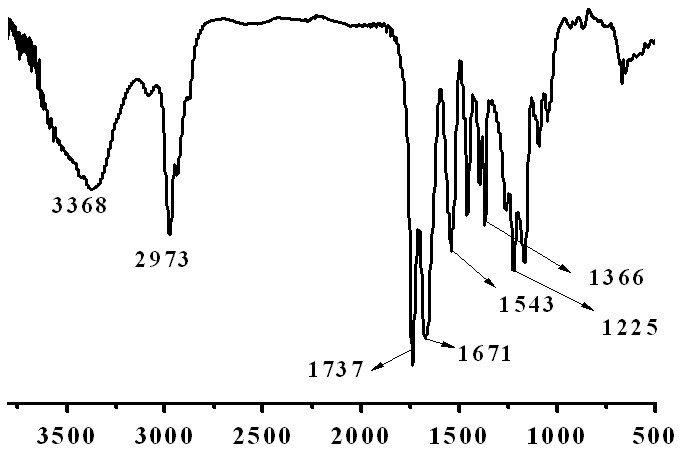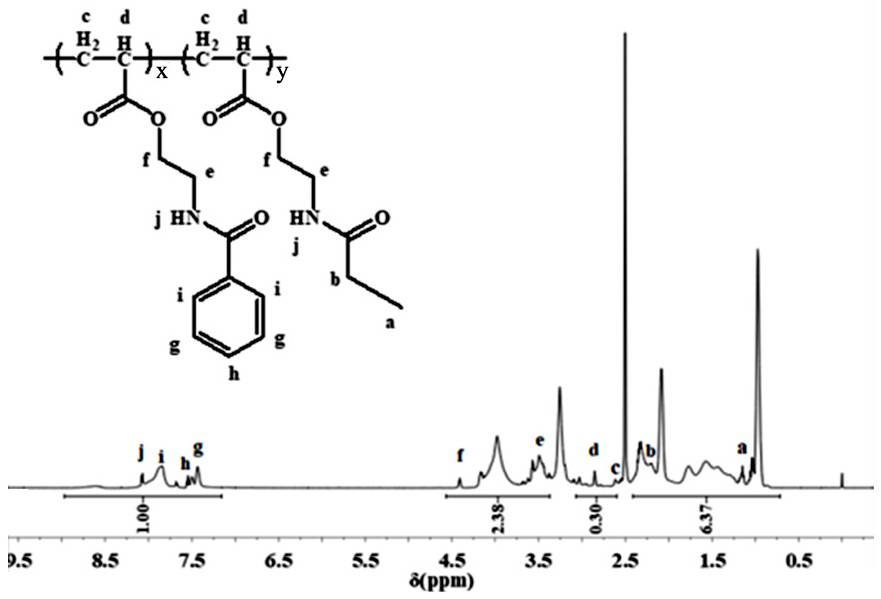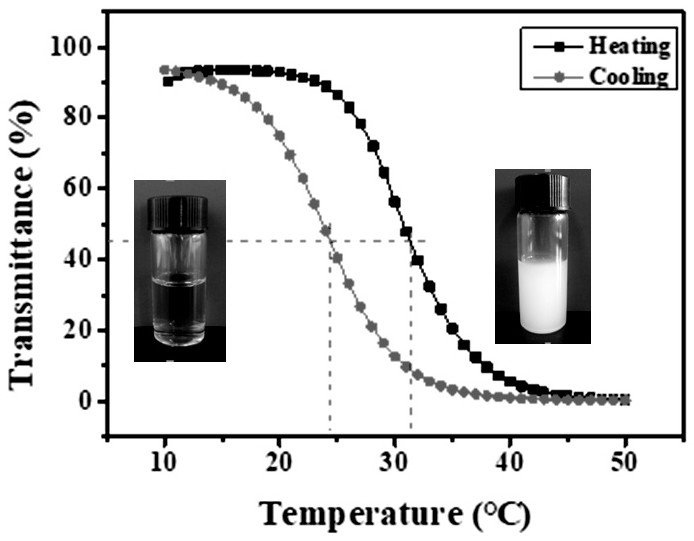A temperature-sensitive poly(propionylaminoethylacrylate-co-benzamidoethylacrylate) and its preparation method
A technology of benzamidoethyl acrylate and propionylaminoethyl acrylate, applied in the field of polymers and their preparation, to achieve good biocompatibility, rapid response, and easy operation
- Summary
- Abstract
- Description
- Claims
- Application Information
AI Technical Summary
Problems solved by technology
Method used
Image
Examples
Embodiment 1
[0038] (a) Typical small molecule ring-opening reaction
[0039] In a 25 mL flask equipped with a magnet, add accurately weighed 0.720 g of acrylic acid monomer and 6 mL of absolute ethanol, and stir for 5 min to make the acrylic acid and ethanol mix evenly. Accurately weigh 0.891 g of 2-ethyl-2-oxazoline and 0.147 g of 2-phenyl-2-oxazoline, add them into the flask, and stir at room temperature for 8 h to ensure that the ring-opening reaction is complete. Thin-layer chromatography (TLC) was used to observe whether the ring-opening reaction of oxazoline and acrylic acid monomer was complete or not with anhydrous ether as developing solvent.
[0040] (b) Free radical copolymerization reaction
[0041] After the reaction of the acrylic acid monomer is complete, accurately weigh 0.026g of azobisisobutyronitrile (AIBN) and add it to the reaction flask, pump out the air in the flask and fill it with dry high-purity nitrogen, repeat 5 times to eliminate the oxygen in the air , to p...
Embodiment 2
[0046] (a) Typical small molecule ring-opening reaction
[0047] In a 25 mL flask equipped with a magnet, add accurately weighed 0.720 g of acrylic acid monomer and 6 mL of anhydrous methanol, and stir for 5 min to make the acrylic acid and ethanol mix evenly. Accurately weigh 0.951 g of 2-ethyl-2-oxazoline and 0.074 g of 2-phenyl-2-oxazoline, add them into the flask, and stir at room temperature for 10 h to ensure that the ring-opening reaction is complete. Thin-layer chromatography (TLC) was used to observe whether the ring-opening reaction of oxazoline and acrylic acid monomer was complete or not with anhydrous ether as developing solvent.
[0048] (b) Free radical copolymerization reaction
[0049] After the reaction of the acrylic acid monomer is complete, accurately weigh 0.034g of azobisisobutyronitrile (AIBN) and add it to the reaction flask, pump out the air in the flask and fill it with dry high-purity nitrogen, repeat 5 times to eliminate the oxygen in the air , t...
Embodiment 3
[0051] (a) Typical small molecule ring-opening reaction
[0052] In a 25 mL flask equipped with a magnet, add accurately weighed 0.720 g of acrylic acid monomer and 6 mL of anhydrous ethyl acetate, and stir for 6 min to make the acrylic acid and ethanol mix evenly. Accurately weigh 0.916 g of 2-ethyl-2-oxazoline and 0.110 g of 2-phenyl-2-oxazoline, add them into the flask, and stir at room temperature for 6 h to ensure that the ring-opening reaction is complete. Thin-layer chromatography (TLC) was used to observe whether the ring-opening reaction of oxazoline and acrylic acid monomer was complete or not with anhydrous ether as developing solvent.
[0053] (b) Free radical copolymerization reaction
[0054] After the reaction of the acrylic acid monomer is complete, accurately weigh 0.020 g of azobisisobutyronitrile and add it to the reaction flask, take out the air in the flask and fill it with dry high-purity nitrogen, and repeat 5 times to eliminate the oxygen in the air an...
PUM
| Property | Measurement | Unit |
|---|---|---|
| molecular weight distribution | aaaaa | aaaaa |
| molecular weight distribution | aaaaa | aaaaa |
| molecular weight distribution | aaaaa | aaaaa |
Abstract
Description
Claims
Application Information
 Login to View More
Login to View More - R&D
- Intellectual Property
- Life Sciences
- Materials
- Tech Scout
- Unparalleled Data Quality
- Higher Quality Content
- 60% Fewer Hallucinations
Browse by: Latest US Patents, China's latest patents, Technical Efficacy Thesaurus, Application Domain, Technology Topic, Popular Technical Reports.
© 2025 PatSnap. All rights reserved.Legal|Privacy policy|Modern Slavery Act Transparency Statement|Sitemap|About US| Contact US: help@patsnap.com



